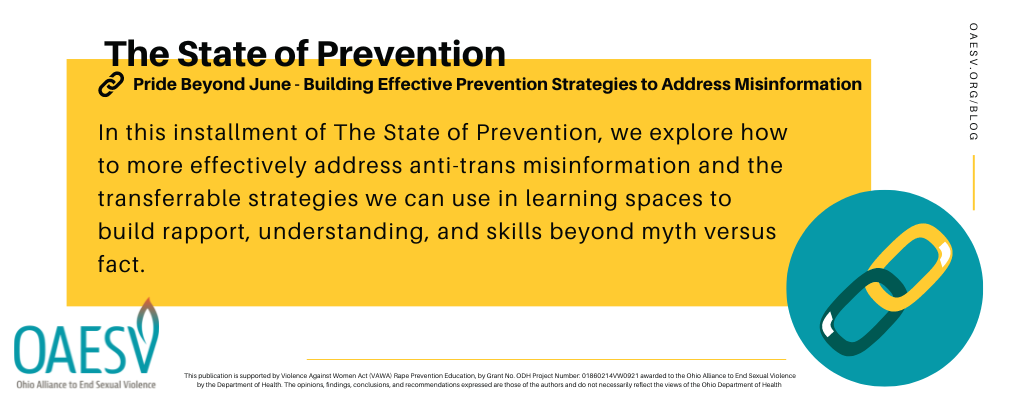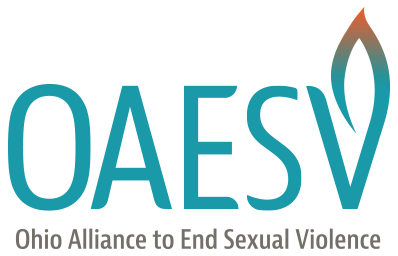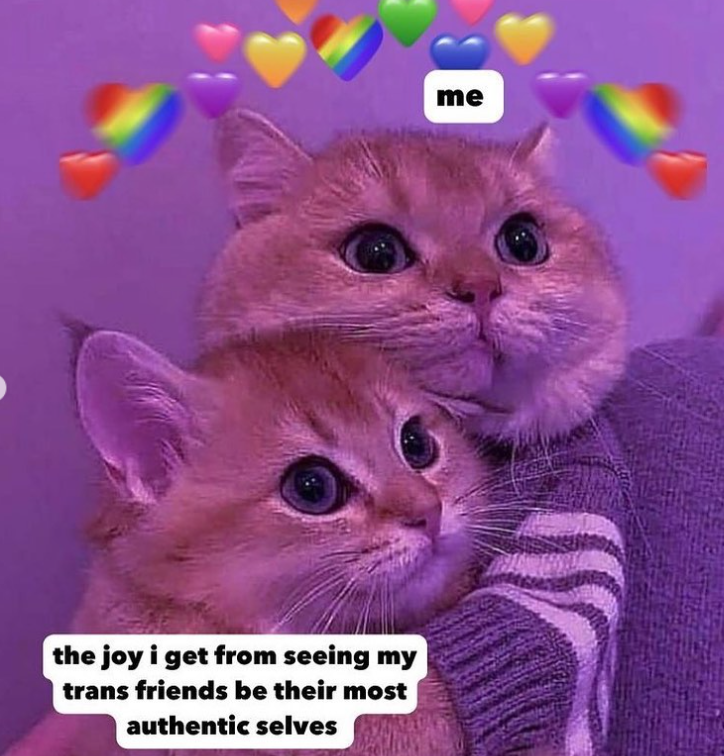
Pride Beyond June: Building Effective Prevention Strategies to Address Misinformation
The first Pride was an uprising. “Invigorated and empowered by the Black Power, anti-war, and women’s liberation movements, the Greenwich Village community had had enough.” On June 28, 1969, The LGBTQIA+ patrons at the Stonewall Inn stood their ground against police in a six-day rebellion to publicly claim queer and trans pride in the face of laws that sought to erase them.
And today the fight continues. So far in 2023, 557 anti-trans bills have been introduced with 87 passed, and even more on the horizon. In Ohio, trans youth are at the center of these struggles for liberation, as queer and trans youth have been throughout history. Revolutionary trans activists Marsha P. Johnson and Silvia Rivera began their efforts in queer and trans liberation as teenagers, most famously known for their frontline efforts during the Stonewall riots.
With anti-trans legislation targeting trans youth today, it is critical that the anti-violence field effectively address the impacts of these attempts to erase trans people and how we can prevent anti-trans violence. One strategy we often rely on in educational settings is myth versus fact. Myth versus fact activities have been a mainstay of the sexual violence prevention handbook for decades, and with good intent! These activities can elicit more classroom engagement, spark lively conversations, and even get a temperature check on learners’ baseline knowledge.
While these are important factors for providing culturally responsive and engaging education, this approach also can reinforce myths by framing a truth within the myth. So, how can we pivot to best practice strategies while still gauging readiness and building rapport? Let’s start with five foundational approaches to integrate into your lessons.
1. Explore Shared Values
Community agreements are a great start. Now consider how to incorporate them as part of each lesson! When posing the question, “What do you need from yourself and others to feel safer learning about sexual violence?” ask students to consider their answers from an actionable lens. When a learner offers “non-judgmental,” we can ask, “What does that look like in action?” This may be interpreted differently by each student, and getting specific while remaining flexible can help develop more meaningful and engaging agreements that can be revisited, especially when talking about the lived experiences of marginalized communities.
2. Approach from a strengths-based perspective.
“Communications that take on and discredit myths do not correct misperceptions.” Instead, explain why trans issues matter, the impacts, and how we can work together to address them.
Try shifting from “while you may think trans youth are transitioning at high rates…” to “everyone deserves to feel at home in their own bodies and receive gender-affirming care on their own terms.” It can be helpful to prioritize bodily autonomy and the benefits of gender-affirming care over debunking the myth of medical transition rates for youth.
To wrap two-in-one, you could include “the right to determine what’s best for ourselves” as a group agreement and revisit this when anti-trans talking points come up alongside the reframed communication approach.
3. Move beyond “sticking to the facts”
“Facts alone do not help contextualize social problems or drive people to action.” While facts absolutely support learning, facts alone do not build skills or change behavior. As people who do this work every day, we can sometimes forget that our communities at large may not be as directly invested in sexual violence as a public health issue. However, this doesn’t mean people don’t care about ending sexual violence. Instead, we can find ways to center the communities’ vested interests and build a bridge to connect them back to sexual violence.
For example, if your community is concerned about youth homelessness rates, this is an opportunity to connect the dots to sexual violence without using the language “risk and protective factors.” Try “It sounds like a big concern here is youth homelessness. What do y’all think are the biggest reasons for this issue? And what do you think we can do to prevent these rates from increasing?” Asking the community what they believe the solutions are and supporting community mobilization efforts to build the protective factors they’ve identified IS sexual violence prevention.
And we can find opportunities to center the margins, uplifting the importance of understanding who is most impacted, to ensure we’re meeting people where they are but not leaving them there. If the community has identified youth not having strong adult connections as a risk factor, we can ask “Who, among all youth, might be most affected by this?” You can fold in facts about how LGBTQIA+ youth of color experience the highest rates of homelessness and ask community members why those numbers are so high for queer and trans youth of color. This can help solidify building out protective environments that address the needs of youth at the intersections of marginalization.
4. Drop the jargon!
GBV, IPV, SV, SA, DV, and well, you get it. We love acronyms in this field!! Almost as much as we love talking in broader strokes, while not always offering relatable examples or metaphors. We can sometimes forget that sexual violence isn’t a topic everyone is very familiar with—or comfortable with— talking about. How can we break down these topics into more manageable introductions, centering the voices of learners in the exploration?
Get familiar with the media content learners of all ages are engaging with and weave them into the learning sessions. Use tv shows, music, YouTube channels, video games, and viral social media moments to talk about the day’s topic. The memeification of topics—using memes to introduce complex ideas—is a great way to ease folks into the conversation with something relatable and lighthearted. This can support building emotional and psychological readiness to dive into topics about violence and reinforce shared values to ground the conversation. Take the meme below. Consider what shared values are being communicated in a new way and even use that as a starting point for discussion.
Additionally, we can reword how we approach these conversations to increase accessibility for more learners. Rather than saying “De-stigmatizing trans existence is critical, and we all play a role in preventing anti-trans violence” try “Trans people have always existed. Attacks on trans people are the newer thing. What are some ways we can support trans people?” This can even include asking learners why they think anti-trans violence is connected to sexual violence so that we get to the “why” without losing learners in the introduction. If you’re struggling with misinformation during this exploratory phase, refer back to your shared values!
5. Center solutions, not crisis.
Yes, attacks on trans youth have reached a fever pitch. And what happens when we present issues without solutions? People might freeze, disengage, or become desensitized to the issue because it feels too big to solve. Responses, or lack there-of, can reflect behavior similar to the bystander effect.
Instead of framing these attacks as “The anti-trans crisis” try “Trans people have always existed, and we can support humanity for all. Here are some ways to get involved…” This helps shift the focus to the small and big ways individual, relationship-, and community-based efforts can prevent the continued rise of anti-trans violence rather than remaining stuck in an overwhelming state.
These strategies are guidance, not prescription. Queer and trans liberation cannot be disconnected from sexual violence prevention, so consider what strategies might work for your teaching style and in your communities to address these intersecting issues. As we navigate increasingly divisive learning environments affected by state and federal politics, we can prioritize transferable strategies to address all types of violence without regurgitating mis- and disinformation through myth versus fact frameworks.
Trans youth belong, and we, as preventionists, have a responsibility to support a safer learning environment where belonging is an embodied practice.
“The State of Prevention” is a blog series that explores Ohio’s prevention landscape, highlighting both history and current events that impact the field.
References:
“Apa Dictionary of Psychology.” American Psychological Association, dictionary.apa.org/bystander-effect. Accessed 29 June 2023.
“Connecting the Dots.” Centers for Disease Control and Prevention, vetoviolence.cdc.gov/apps/connecting-the-dots/content/discover-connections. Accessed 29 June 2023.
“Five Framing Tips: Framing for Social Change.” FrameWorks Institute, www.frameworksinstitute.org/article/five-framing-tips-framing-for-social-change/. Accessed 29 June 2023.
“Homelessness and Housing Instability among LGBTQ Youth.” The Trevor Project, 2 Feb. 2022, www.thetrevorproject.org/research-briefs/homelessness-and-housing-instability-among-lgbtq-youth-feb-2022/.
“Snapshot: LGBTQ Equality by State.” Movement Advancement Project, www.lgbtmap.org/equality-maps/equality-maps. Accessed 29 June 2023.
“Supporting the Transgender People in Your Life: A Guide to Being a Good Ally.” National Center for Transgender Equality, 27 Jan. 2023, transequality.org/issues/resources/supporting-the-transgender-people-in-your-life-a-guide-to-being-a-good-ally.
“Weekend Read: The First Pride Was a Riot.” Southern Poverty Law Center, 22 June 2019, www.splcenter.org/news/2019/06/22/weekend-read-first-pride-was-riot.

